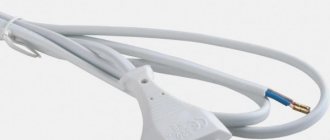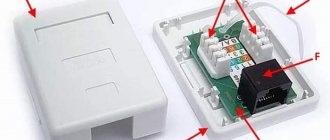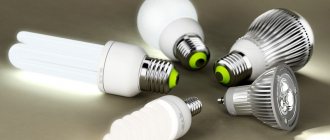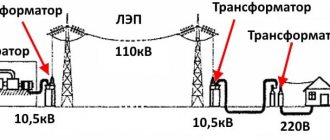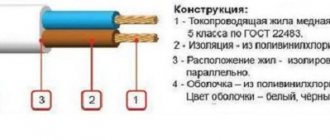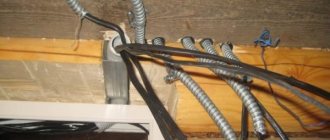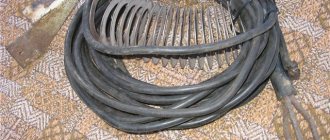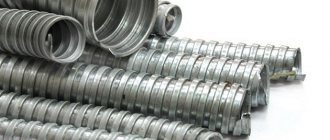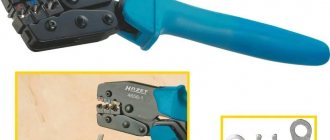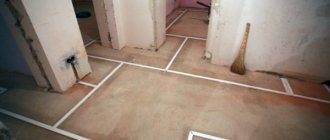Three-core wire ShVVP
ShVVP brand wires are widely used in the domestic sphere. They are used as cords for household appliances or as extension cords. But in production and for powering powerful consumers, this type of wire is practically not used, and if it is used, it is only as temporary power. And in order to figure out what this is connected with, let's look at this brand of wire in more detail.
Decoding
If we consider in detail the meaning of the abbreviation SHVVP, it will become clear that this is not a wire or a cable, but a cord. A cord is an electrical product designed to connect consumers to an alternating current network and having several (at least two) cores. The current-carrying conductors are mainly elastic and have a cross-section of up to 0.75 mm2.
Attention! If the housing of the connected household appliance does not require a grounding conductor, then the cord has two conductive wires. According to GOST 7399 - 97, this is a household cord. In other cases, the cords are multi-core products.
Three-core ball screw
The marking is an inscription that combines letters and numbers. It is applied to the surface of the conductor every meter. The decryption has the following meaning:
- Ш – cord;
- B – polyvinyl chloride (PVC) sheath of current-carrying conductors;
- B – polyvinyl chloride (PVC) outer shell;
- P – flat.
Double insulation makes the cord safer with respect to electrical effects on humans. In addition, PVC materials are not subject to active combustion.
Purpose of the PUNGP wire
Wire PUGNP
An electric cable is a type of PUNP with flexible conductors. It is cheaper in comparison with NYM or VVG and until 2007 it was manufactured according to TU 16.K13-020-93. The low quality of products for organizing the electrical network was the reason for the ban on production. Currently, some manufacturers produce PUNGP, so after purchasing it you need to check it:
- put in a freezer at a temperature of -15 degrees and inspect the shell for cracking;
- After keeping the twist in the freezer for about 2 hours, warm it up for 60 minutes at room temperature and wind it onto a cylinder 10 times longer.
If the cable housing remains intact, it can be used for its intended purpose - for arranging interior lighting, power supply to small household appliances and industrial units.
ShVVP cord design
The decoding of the abbreviation almost completely describes the structure of the cord. However, there are several more design characteristics:
- core design;
- number of current-carrying components;
- location of current leads;
- coloring.
SIP cable 2: technical characteristics
The cord cores are made of copper. They have a round cross-section (0.5 or 0.75 mm2) and consist of many wires. This is done to increase the flexibility of the product.
For your information. GOST implies the presence of 7 wires with a cross-section of 0.35 and 0.38 mm2, for ShVVP 2*0.5 and ShVVP 2*0.75, respectively.
The number of cores in an electrical product is two or three. The conductors are located under the outer insulation parallel to each other. The thickness of the outer PVC sheath must be more than 0.6 mm, and the thickness of the core insulation must be more than 0.5 mm.
Color coding identifies the following conductors:
- zero – blue insulation;
- phase – brown insulation;
- the grounding conductor is yellow-green (if present).
Important! If the plug has special contacts, and the socket allows its connection to the grounding bus, then the use of a grounding conductor of the cord is mandatory.
Cord structure
Installation features
Considering the properties of the wire, it can be laid as follows:
- inside the plaster layer - when performing wiring;
- in the form of an open line - with fastening to a flat surface, which facilitates the shape of the cable.
Also read: Technical characteristics of the cable - ASB
When making connections, conductors of the same name are twisted or connected with terminals, followed by insulation of the twist. If the cable is located outdoors, steel pipes or a corrugated sleeve are used as additional protection.
Species diversity
KVVG cable
The manufacturer can change the color marking, both external and the color of the core insulation. The designation SHVVP does not indicate a specific color, so black cord is also found. The manufacturer has the right, based on GOST-7399-97, to change the color scheme. But this does not in any way affect the quality and price.
Carefully. When purchasing this product, in which the cross-section of the current-carrying conductor is indicated as 3; 4; 6 mm2, you need to remember that it does not comply with this GOST. This means that the product is not certified.
How to choose PVS wire
The first thing you should pay attention to when choosing any electrical cable or wire is the number and cross-section of cores, selected in accordance with operating conditions. You need to select a PVA depending on the power of the electrical appliances that will be switched to the network through it
The presence or absence of a grounding conductor, which allows connecting the electrical appliance and the ground loop, is important. For example, when laying an industrial network, you need to use a PVA with four cores
At least, this is how it is stated in the rules of the PUE.
Each manufacturer must submit a sample of their wire. While studying it, make sure that the individual core is twisted correctly. Poor quality can be judged by the presence of stains, breaks, different colors and other defects that are visible to your eye. On the marking you can see not only the number of cores and their cross-sectional area, but also find out about the percentage of copper content.
To ensure safe and energy-efficient operation of electrical equipment, it is important to select the appropriate PVS wire. If you encounter any difficulties in the process of choosing a product, seek help from professional installers or store consultants
However, you should not believe every word of the latter. Ideally, you should study the basic information regarding PVA and, armed with knowledge, go shopping.
Specifications
Cable PUGNP
Shvvp wires have the following technical characteristics:
- mechanical - describing the device of the product and design parameters;
- electrophysical - telling about the electrical characteristics for a given type of cord, based on the physical properties of the materials.
When operating a conductor, both are of no small importance, so they are considered separately.
Mechanical
The main mechanical parameters include:
- flexibility;
- permissible number of bends and extensions;
- tensile strength;
- temperature stability.
The minimum Rbend (bending radius) for ball screws is equal to five cable diameters. The geometric feature of the cord is flat, so the smallest diameter is taken.
Minimum bend radius
The cord allows you to perform at least 30 thousand “flexion-extension” cycles during its operation.
By the way. The more similar cycles a product has experienced, the shorter its service life. Wires that are constantly exposed to such mechanical loads last no more than 2 years, with static use - 10 years.
In tensile tests, this product must withstand loads of up to 9.8 N, which is 1 kgf. Such a load should not cause external damage to the cord.
The temperature resistance of the conductor must be able to withstand exposure to high and low temperatures. When tested, a certified ball-and-ball screw can withstand the influence of T = +800C for 90 hours. Moreover, after the cord cools down, there are no signs of damage on it. Tests at low temperatures are performed by mechanical pressure (rolling through rollers) and impacts.
Limit standards for normal operation – from - 250С to +400С.
Attention! When operating a consumer connected using such a cord, the maximum permissible core temperature is +700C. If the temperature exceeds this value, it means that the cross-section of the conductors is selected incorrectly.
Electrophysical
Electrical characteristics for the wire are the reference criterion when choosing a product.
These parameters include the following items:
- conductor resistance;
- insulation resistance;
- permissible current load.
The resistance for the conductors under consideration with two reference sections of cores (0.5 and 0.75 mm2) is equal to 39 Ohm/km and 26 Ohm/km. This is true under the conditions that the diameter of the wire in the bundle is no more than 0.16 mm, and the direct current resistance was measured at a temperature of 200C.
GOST-7399-97 regulates the insulation resistance value of more than 0.012 Mohm/km for a copper section of 0.5 mm2 heated to 700C, and 0.01 Mohm/km for 0.75 mm2.
Information. Insulation resistance is measured between wires and between each wire and ground.
An acceptable load is considered to be one in which the current flowing for a long time through the conductor under load does not heat the conductors above the permissible (operating) temperature. For both sections, the permissible current is 2.5 and 6 A, respectively.
How to choose a high-quality VVG and AVVG cable?
Nowadays, finding a high-quality cable is quite difficult, because there are a lot of small companies selling cheap cables under the guise of high-quality products. In this regard, craftsmen have to be vigilant and carefully inspect the cable before purchasing and installing.
The first thing you need to check before purchasing a cable is the tag and certificate for the cable. The tag of a quality product from a trusted manufacturer will necessarily indicate the name of the manufacturer or its trademark, the length of the product and the date of its manufacture, a technical control stamp and a mark of conformity. The highest quality products are made according to GOST standards.
When inspecting the certificate, be sure to pay attention to the name of the manufacturer, which must be in full, as well as the expiration date of the certificate. Do not forget to study the names, signatures of managers and the seal of the company.
If the tag and certificate are in order, then half the battle is already done, and we are dealing with a company that has the right to produce VVG and AVVG cables
Unfortunately, even the most famous manufacturers in one batch or another decide to save on material and make a product of poorer quality. Therefore, it is necessary to study the cable itself.
If the tag and certificate are in order, then half the battle is already done, and we are dealing with a company that has the right to produce VVG and AVVG cables. Unfortunately, even the most famous manufacturers in one batch or another decide to save on material and make a product of poorer quality. Therefore, it is necessary to study the cable itself.
The main quality criterion, which can be checked directly at the point of sale, is the actual cross-sectional area of the cable core. Often, saving on materials, the manufacturer greatly underestimates this value, which significantly worsens the electrical resistance of both the VVG and AVVG cables. Therefore, when choosing a product, you often have to arm yourself with a caliper and calculate the cross-sectional area of the core using the formula for determining the area of a circle:
S=π*R2 or S=(π*D2)/4, where D is the diameter of the core, measured using a caliper, and R is the radius of the core, i.e. the same value halved. Well, π = 3.14.
The resulting value should be compared with the value indicated on the packaging. A slight difference is completely acceptable, since the nominal value is indicated on the package, but if the value is more than 25% less than declared, the cable should be discarded.
Choosing the right VVG and AVVG cable is a serious matter, which in the future will allow you to get rid of a bunch of unnecessary problems. Of course, in addition to the steps described, before installation it is advisable to check the quality of the cable insulation, as well as the presence of breaks and short circuits, however, this is impossible to do in a store. Therefore, you should be content with what is already known about the product.
Cables of the VVG and AVVG brands are among the most common, which is why there are many low-quality products. The main thing to remember is that you should not skimp on wiring and trust incomprehensible, uncertified manufacturers. It is better to turn to those who are not afraid to put their name on the product, like the participants in the project “Against counterfeiting in the cable market.”
We sell only high-quality cables, wires and couplings from reliable manufacturers. Call +375 17 207-24-16 (17,18,19).
Where is it used?
The shvvp wire, the decoding of which speaks about its features, is used mainly for connecting to a 220 V AC network in everyday life. It is convenient to connect household electrical appliances (hair dryers, irons, refrigerators, TVs and much more) using a flexible conductor. Carrying cases and various extension cords are also made from a similar cord and are practical. It is not recommended to connect permanent electrical installations.
Wire Application Table
Manufacturers
Among the most well-known manufacturers of ball screws in Russia are the following companies:
- Rybinskcable,
- SKK (Samara Cable Company),
- Electric cable,
- Parity and others.
ShVVP has become widespread in the domestic sphere. In industrial enterprises, this product is used to a limited extent, given its characteristics, and can be used to connect lighting devices and equipment of low power.
Video testing the cable for flammability
Dangers of use
It is unacceptable to use the cord for several household appliances connected to it at the same time. Even if their individual power is small, it may turn out that the total power exceeds what is permissibly possible for ballast cables, the characteristics of which are not designed for a continuous current load exceeding 6 A.
For example, using such a cord, even with a cross-section of 0.75 mm2, we connected an outlet in the kitchen. Using a tee, a microwave oven, an electric kettle and an electric stove were simultaneously connected to it. The average power of connected consumers is:
- stove - 2.5 kW;
- microwave – 1.8 kW;
- electric kettle – 1.2 kW.
The total power of three household appliances will be 5.5 kW. With a network voltage of 220 V, the total current consumption will be equal to 25 A. This means that when the devices are turned on simultaneously, the current value will exceed the permissible value by 4 times. The wire will not hold up and will burn, which can cause a general fire.
There are several common reasons why the rule for using such a cord is violated, namely:
- imaginary ease of installation - flexibility;
- remnants of material that are a pity to throw away;
- double insulation.
Double insulation and temperature range (-25-+400C) are misleading to the average person, but should not confuse a specialist. The insulation is not thick enough, and moisture and temperature changes can damage it if the wiring is exposed. In any case, GOST-7399-97 and OKOF 143131040 prescribe not to use this electrical product to power stationary power units (PS).
Attention! For control systems, power cables and wires with conductors of a suitable cross-section, insulation of sufficient thickness and a large current reserve are used.
The flexible SHVVP cord will serve efficiently and for a long time if you do not violate the methods of its use. A correctly selected cross-section corresponding to the load power will ensure proper safety during its operation.
Application area
Due to the fact that the cross-section of the conductors of the SHVVP cord most often does not exceed 2.5 mm2, it cannot be used to connect powerful electrical appliances. Despite the fact that the maximum cross-section of the cores allows you to connect some electrical appliances with a power of 1-2 kW using SHVVP, the following cord sizes are most often used at home: 2 * 0.5; 2*0.75; 2*1.5; 3*0.75; 3*1.5.
As a rule, the scope of application of the ball screw cord is as follows:
- Used to connect low-power electrical appliances: kettle, table lamp, radio equipment, etc. Some craftsmen make “carries” using this electrical wire. If you suddenly decide to make an extension cord with your own hands, it is better to choose a more reliable analogue - PVS wire.
- It is used when installing lighting, both street and indoor. In my practice, I have more than once come across a cord with this marking, which connects LED strips to the power supply.
As you can see, the use of ball screws is not appropriate everywhere, which is due to the small cross-section of the cores. At home, we recommend using a cord with this marking not for all wiring, but only when installing lighting in rooms!
Prices from applications
| ShVVP 2x0.75 | 8 500 | rub./km |
| ShVVP 2x0.75 | 10 000 | rub./km |
| ShVVP 2x0.75 | 10 000 | rub./km |
| ShVVP 2x0.75 | 10 800 | rub./km |
| ShVVP 2x0.75 | 10 800 | rub./km |
| show 10 more ↓ | ||
| ShVVP 2x0.75 | 10 800 | rub./km |
| ShVVP 2x0.75 | 10 800 | rub./km |
| ShVVP 2x0.75 | 12 332 | rub./km |
| ShVVP 2x0.75 | 12 500 | rub./km |
| ShVVP 2x0.75 | 13 310 | rub./km |
| ShVVP 2x0.75 | 13 310 | rub./km |
| ShVVP 2x0.75 | 13 310 | rub./km |
| ShVVP 2x0.75 | 13 586 | rub./km |
| ShVVP 2x0.75 | 13 800 | rub./km |
| ShVVP 2x0.75 | 17 720 | rub./km |
View applications
Buy from stock
| ShVVP 2x0.75 | Moscow | 706,307 | km |
| ShVVP 2x0.75 | Saransk | 333,558 | km |
| ShVVP 2x0.75 | Trekhgorny | 298,110 | km |
| ShVVP 2x0.75 | Novosibirsk | 284,865 | km |
| ShVVP 2x0.75 | Ekaterinburg | 257,171 | km |
| show 65 more ↓ | |||
| ShVVP 2x0.75 | Yaroslavl | 131,788 | km |
| ShVVP 2x0.75 | Tver | 102,243 | km |
| ShVVP 2x0.75 | Izhevsk | 95,140 | km |
| ShVVP 2x0.75 | Krasnogorsk | 94,600 | km |
| ShVVP 2x0.75 | Nizhny Novgorod | 91,307 | km |
| ShVVP 2x0.75 | Samara | 78,358 | km |
| ShVVP 2x0.75 | Rostov-on-Don | 76,456 | km |
| ShVVP 2x0.75 | Podolsk | 75,715 | km |
| ShVVP 2x0.75 | Penza | 64,277 | km |
| ShVVP 2x0.75 | Saint Petersburg | 63,011 | km |
| ShVVP 2x0.75 | Kazan | 43,572 | km |
| ShVVP 2x0.75 | Tula | 40,553 | km |
| ShVVP 2x0.75 | Irkutsk | 40,063 | km |
| ShVVP 2x0.75 | Permian | 36,457 | km |
| ShVVP 2x0.75 | Chelyabinsk | 27,231 | km |
| ShVVP 2x0.75 | Khabarovsk | 26,209 | km |
| ShVVP 2x0.75 | Minsk | 18,336 | km |
| ShVVP 2x0.75 | Krasnodar | 15,781 | km |
| ShVVP 2x0.75 | Voronezh | 15,410 | km |
| ShVVP 2x0.75 | Tyumen | 14,925 | km |
| ShVVP 2x0.75 | Petrozavodsk | 14,494 | km |
| ShVVP 2x0.75 | Krasnoyarsk | 13,205 | km |
| ShVVP 2x0.75 | Omsk | 11,484 | km |
| ShVVP 2x0.75 | Tomsk | 7,100 | km |
| ShVVP 2x0.75 | Klimovsk | 5,400 | km |
| ShVVP 2x0.75 | Kostroma | 5,159 | km |
| ShVVP 2x0.75 | Yakutsk | 5,101 | km |
| ShVVP 2x0.75 | Syktyvkar | 4,198 | km |
| ShVVP 2x0.75 | Domodedovo | 4,000 | km |
| ShVVP 2x0.75 | Sochi | 3,911 | km |
| ShVVP 2x0.75 | Pskov | 3,852 | km |
| ShVVP 2x0.75 | Khimki | 3,709 | km |
| ShVVP 2x0.75 | Murmansk | 3,694 | km |
| ShVVP 2x0.75 | Tolyatti | 3,428 | km |
| ShVVP 2x0.75 | Cheboksary | 3,369 | km |
| ShVVP 2x0.75 | Evpatoria | 3,175 | km |
| ShVVP 2x0.75 | Orsk | 2,847 | km |
| ShVVP 2x0.75 | Lipetsk | 2,602 | km |
| ShVVP 2x0.75 | Saratov | 2,277 | km |
| ShVVP 2x0.75 | Volgograd | 2,255 | km |
| ShVVP 2x0.75 | Orenburg | 2,117 | km |
| ShVVP 2x0.75 | Kolchugino | 1,970 | km |
| ShVVP 2x0.75 | Ivanovo | 1,758 | km |
| ShVVP 2x0.75 | Velikiy Novgorod | 1,587 | km |
| ShVVP 2x0.75 | Stavropol | 1,585 | km |
| ShVVP 2x0.75 | Ufa | 1,497 | km |
| ShVVP 2x0.75 | Kotlas | 1,215 | km |
| ShVVP 2x0.75 | Kostanay | 1,000 | km |
| ShVVP 2x0.75 | Zhukovsky | 0,949 | km |
| ShVVP 2x0.75 | Engels | 0,903 | km |
| ShVVP 2x0.75 | Astrakhan | 0,881 | km |
| ShVVP 2x0.75 | Naberezhnye Chelny | 0,835 | km |
| ShVVP 2x0.75 | Arkhangelsk | 0,705 | km |
| ShVVP 2x0.75 | Kemerovo | 0,643 | km |
| ShVVP 2x0.75 | Shchelkovo | 0,507 | km |
| ShVVP 2x0.75 | Miass | 0,459 | km |
| ShVVP 2x0.75 | Magnitogorsk | 0,457 | km |
| ShVVP 2x0.75 | Velikie Luki | 0,339 | km |
| ShVVP 2x0.75 | Kirovo-Chepetsk | 0,265 | km |
| ShVVP 2x0.75 | Pyatigorsk | 0,210 | km |
| ShVVP 2x0.75 | Ulyanovsk | 0,183 | km |
| ShVVP 2x0.75 | Karaganda | 0,100 | km |
| ShVVP 2x0.75 | Severodvinsk | 0,066 | km |
| ShVVP 2x0.75 | Pavlodar | 0,061 | km |
| ShVVP 2x0.75 | Kirov | 0,050 | km |
View suppliers
Video review
Sources
- https://www.asutpp.ru/provod-shvvp.html
- https://cable.ru/cable/group-shvvp_description.php
- https://220.guru/electroprovodka/provoda-kabeli/shvvp.html
- https://amperof.ru/elektromontazh/electroprivodka/kabel-shvvp.html
- https://ProFazu.ru/provodka/cable-wire/provod-shvvp.html
- https://samelectrik.ru/texnicheskie-xarakteristika-shnura-shvvp.html
- https://OFaze.ru/elektrosnabzhenie/kabel-shvvp
- https://electricvdele.ru/elektroprovodka/kabeli-i-provoda/tehnicheskie-harakteristiki-shnura-shvvp.html
- https://Elektrik-a.su/kabeli-i-provoda/silovye/provod-shvvp-519
